The San Jose Sharks had a strong draft, selecting all forwards in 2020. The 2020-21 season was a difficult one for development with many leagues not running either at all or not at full capacity. Despite this, the Sharks prospects from the 2020 Draft made strides toward their goal of playing for the NHL club someday. Let’s check in on them!
Ozzy Wiesblatt (Round 1, 31st Overall)
The Sharks’ first-round pick from 2020 had a strong Western Hockey League (WHL) season for the Prince Albert Raiders with three American Hockey League (AHL) games for the Barracuda both at the beginning and end. Wiesblatt’s first few AHL games weren’t great. As an 18-year-old, that isn’t a huge surprise. He did score his first professional goal in a Feb. 12, 2021 game against the Texas Stars.
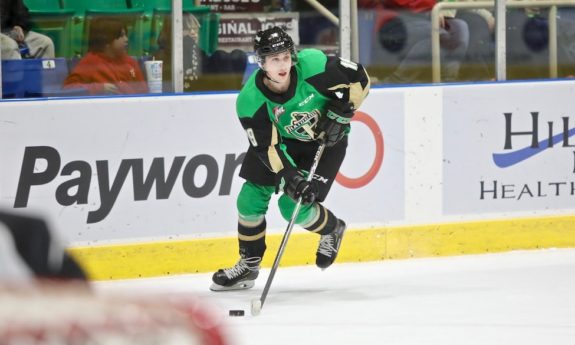
Once he got back to Prince Albert, he got on a roll. He followed up his 1.1 points-per-game draft season with a 1.2 points-per-game draft plus one season. Wearing the alternate captain “A” for the Raiders, he played in all situations and posted a .66 net expected goals (NxG), which is the expected goals for minus expected goals against. Anything over .5 is good and that is what Wiesblatt achieved. An extremely reliable player at the AHL level who is able to tilt the ice in all situations, he is a coach’s dream. It remains to be seen if he can have the same effect professionally.
According to Pick224, Wiesblatt had the 10th-most primary points (goals or primary assists) per game of any draft plus one player. This is a pretty promising result, but you’d certainly like to see him higher on that list. It would make sense that a few guys (Jake Neighbours, Connor Zary, Ridley Greig, and Seth Jarvis) who were drafted before Wiesblatt would be ahead of him, but two of them (Tristen Robins and Justin Sourdif) were taken after Wiesblatt and three were not drafted at all (Simon Knak, Jalen Luypen, and Josh Pillar).
According to Hockey Prospecting, Wiesblatt had a 12 percent chance of being a star producer (.7 points per game for his NHL career) in his draft season and that fell to 11 percent this season. His chance of making the NHL rose from 45 percent to 53 percent. His NxG of .61 for the Barracuda this season suggests he can hang in the AHL and that is a positive sign. Because he won’t turn 20 until March 2022, he will be in the WHL for next season, so the wait for him is still likely two to three seasons until he plays meaningful NHL minutes.
Thomas Bordeleau (Round 2, 38th Overall)
Thomas Bordeleau had a fantastic draft plus one season for the Michigan Wolverines. He tied his teammate Brendan Brisson for the second-most primary points per game in the NCAA for any player in the season after they were drafted. His 30 total points in 24 games led the team, ahead of first-time draft-eligible Kent Johnson, Matthew Beniers, and Owen Power. He won the Tim Taylor Award as most outstanding freshman in the NCAA as well as Sharks prospect of the year.
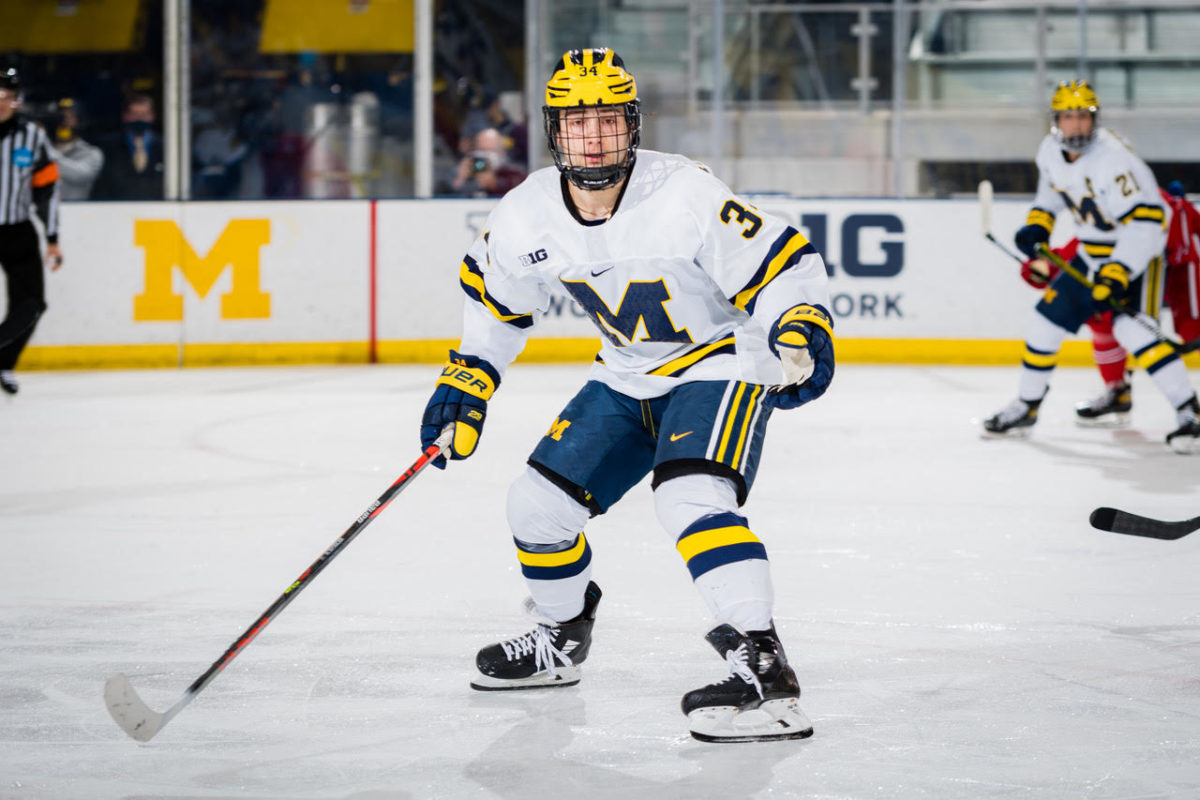
Unfortunately, we didn’t get to see Bordeleau don the stars and stripes for the World Junior Championship in Alberta, Canada. He made the team, but his roommate John Beecher tested positive initially, and even though a second test was negative, the IIHF rules deemed them both ineligible. The United States won gold without him and his teammate Beniers played a big part in that. For the Wolverines, Bordeleau played almost 17 minutes per night with 2:20 coming on the power play and 1:19 with the man down. He landed almost three shots a game and had a dominant .79 NxG and 61 percent Corsi. Those are the types of numbers that suggest he took a strong step forward in his development.
Bordeleau is set to return for his sophomore season and the Wolverines will be loaded, especially if 2021 NHL Entry Draft projected first-overall pick, defender Power, chooses to return. They will also have 2021 first-round ranked Luke Hughes, brother to both Jack and Quinn Hughes. Beniers and Johnson should also be back, along with many other talented players. Bordeleau hopes to take yet another step in his development. He may leave after his sophomore season, in which case it is probably a two- to three-year wait on Bordeleau for the NHL, similar to Wiesblatt.
Tristen Robins (Round 2, 56th Overall)
Robins had one of the best seasons amongst this group, albeit abbreviated. His 23 points in 16 games for the WHL’s Saskatoon Blades was good for fourth amongst draft plus one players. Yes, far better than their first-round pick Wiesblatt, which has an extra layer of interest since they are fierce rivals in the WHL and now part of the same organization.
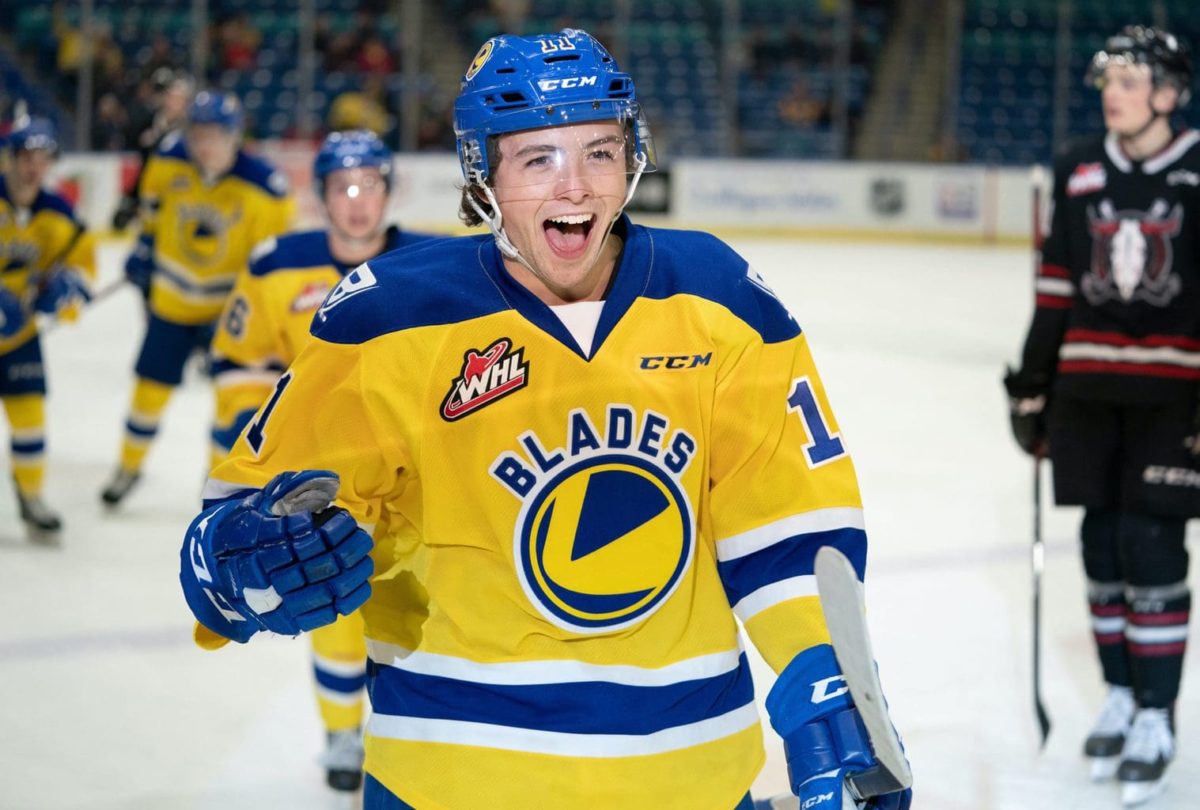
Unfortunately for Robins, his season was cut short due to an MCL sprain he suffered on April 11, 2021. He played a lot for the Blades, 21:38 of average time on ice per game, including 3:30 on the power play and 2:30 shorthanded. He was pretty dominant in that time, too, with a 56 percent Corsi and .77 NxG. His 4.3 shots per game were really nice to see and suggests he is not shy about firing the puck. Interestingly, he and Wiesblatt own the exact same star and NHL potential according to Hockey Prospecting, as if this rivalry needed any more fuel. Robins is old enough to be in the AHL in 2021-22, but Wiesblatt is not, so they may not continue to be rivals, unless there is an amendment to the CHL-NHL agreement.
Daniil Gushchin (Round 3, 76th Overall)
Daniil Gushchin was one of the many prospects affected by the Ontario Hockey League (OHL) not playing any games this season. He was supposed to play for the Niagara IceDogs, who selected him fourth overall in the Canadian Hockey League (CHL) import draft, but had to find somewhere else to play when the league didn’t get going. Fortunately, his old team, the Muskegon Lumberjacks of the United States Hockey League (USHL), took him back. Gushchin continued to dominate the lesser competition of the USHL. His 64 points in 46 games were good for fifth in the league and all four of the players ahead of him played for the stacked Chicago Steel. He had six more points than the next closest player on his team and he did it in five fewer games.
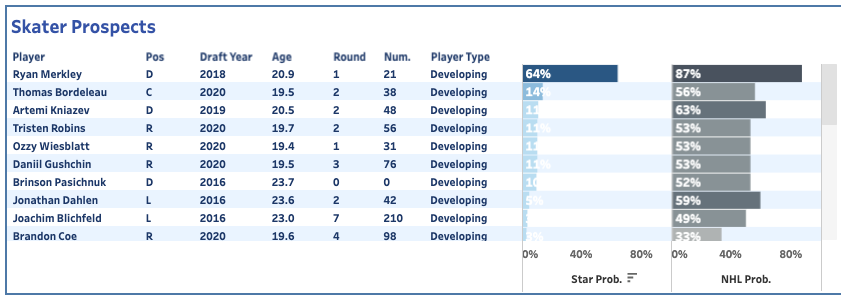
Gushchin has grown two inches since he was drafted, which was one of the biggest knocks on him. His current 5-foot-10 is much more realistic for an NHL player than 5-foot-8. In addition to growing taller, he was able to raise his NxG from .52 in his draft season to .62, although his Corsi fell from 61 percent to 53 percent. Part of that might certainly be a team effect. Hopefully in 2021-22 we finally get to see him compete in the OHL.
Brandon Coe (Round 4, 108th Overall)
Coe was impacted by the OHL shut down just like Gushchin, but since Coe didn’t really have any other options, he came to San Jose to play in the AHL for the Barracuda. This was a huge jump in skill for him, who won’t turn 20 until Dec. 1, 2021. Coe struggled the AHL, which isn’t terribly surprising for the youngster.

He failed to generate an average of even one shot on goal per game (.67) for the Barracuda. He similarly struggled with a poor NxG (.23) and Corsi of 42 percent. I wouldn’t expect such a young player to drive play in the AHL, and frankly, it could have been much worse for him. Toward the end of the AHL season, Coe increased his time on ice, capping out at 17:31 in his final game on May 23, 2021. He also had a handful of games with a positive NxG and Corsi percentage.
Coe should be back in the AHL for 2021-22, though he could also return to the OHL, which wouldn’t be a bad outcome for him either. He will look to build on the limited success he had and be a more consistent producer. He’ll use the offseason to work on skating and strength, while integrating what he learned this season to build strong habits. He has a lot of work to do in order to overcome the low 33 percent of becoming and NHLer.
Alex Young (Round 7, 196th Overall)
Alex Young was drafted as an overager as he was passed over in his first eligible season to be drafted in 2019. After two extremely successful seasons in the lower equivalency Alberta Junior Hockey League (AJHL), he made the jump to the NCAA for Colgate. As a Raider, he scored 13 points in 21 games, tied for the most on the team with senior Josh McKechney. Young didn’t have a good NxG (.31), but did drive play with 54 percent Corsi. He is a long shot to make the NHL, but if he can build on this freshman success, he might be able to play professional hockey, at least in a limited role.
Adam Raska (Round 7, 201st Overall)
Adam Raska began his draft plus one season in the Czech league on loan to HC Ocelari Trinec where he had no points in two games and then HC Frydek-Mistek where he had one assist in 11 games. Back in the Quebec Major Junior Hockey League (QMJHL) for the Rimouski Oceanic, he excelled, eclipsing the point-per-game mark with 25 points in 22 games and six more in eight playoff games. He also appeared in four games for the Czech Republic at the Under 20 World Junior Championship in Red Deer, Alberta.
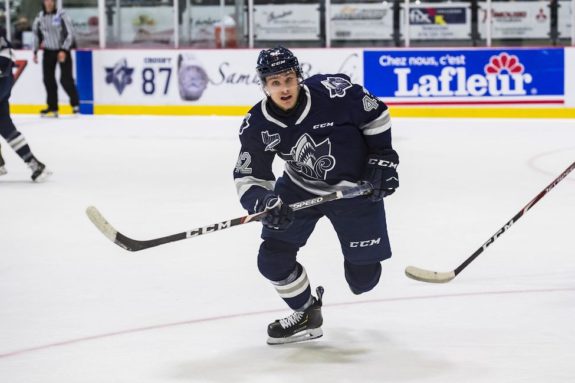
One issue that Raska has is crossing the line and racking up the penalty minutes. In his draft season, he accumulated almost a minor penalty per game, costing his team on many occasions. This, to go along with his almost three hits per game, signifies the kind of grittiness he can bring. This season, he was able to almost cut his penalty minutes in half while gaining an average two minute increase of ice time, which was a real positive sign. All of this while maintaining a 2.7 hits per game average. He’s eligible for the AHL in 2021-22, but would probably benefit from another season in the QMJHL.
Linus Oberg (Round 7, 206th Overall)
Another overager, Linus Oberg was passed over by all NHL teams in 2019. In 2020, he earned a call up to the Swedish Hockey League (SHL) as a 19-year-old and impressed some. At the Under 20 World Junior Championship in the Czech Republic in 2020, he was an important part of Sweden bringing home the bronze medal. There are certainly some who were optimistic Oberg could be a steal in the 2020 Draft, but it isn’t looking that way so far.
This season was a struggle for Oberg as he played the entire season in the SHL as a 20-year-old. His Corsi dropped from 55 percent to 49 percent, though he was able to raise his NxG from a miserable .19 to .39. He also increased his physical presence, landing almost a hit per game, up from .77 last season. Playing an extra 2:13 per game probably helped. Oberg is a long shot to make the NHL, especially as an overager. He will have to have great improvement next season to have a realistic shot.
Timofei Spitserov (Round 7, 210th Overall)
Timofei Spitserov is a Russian-born player who came to the United States at a young age to attend the Culver Military Academy and play hockey. The 2020-21 season was his second playing for the academy, and he led the team again in points. In 2019-20, he led the team by 30 points and by 12 in 2020-21, so he clearly needs to play against tougher competition.
Luckily, it looks like he will do that as he’s set to play for the University of Vermont of the NCAA in 2021-22. According to the Hockey Prospecting model, he increased his NHLer probability from 19 percent to 21 percent, so still unlikely, but better. It will be very telling to see how he does against much tougher competition in the NCAA.
Net Positive
During a very tenuous season during a pandemic, it was tough for some players to find adequate ice time and appropriate competition. All around, all of the players the Sharks selected were able to play a fair amount and develop, save for the injury to Robins. The prospect pyramid will be updated after the 2021 NHL Entry Draft, but things are still looking very promising for the 2020 crop.
Insights by InStat